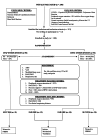Comparison of High Flow Nasal Cannula and Continuous Positive Airway Pressure in COVID-19 Patients With Acute Respiratory Distress Syndrome in Critical Care Unit: A Randomized Control Study
- PMID: 37876393
- PMCID: PMC10590770
- DOI: 10.7759/cureus.45798
Comparison of High Flow Nasal Cannula and Continuous Positive Airway Pressure in COVID-19 Patients With Acute Respiratory Distress Syndrome in Critical Care Unit: A Randomized Control Study
Abstract
Background and objective Acute hypoxic respiratory failure in coronavirus disease 2019 (COVID-19) pneumonia has been treated with oxygen delivered by oxygen masks and non-invasive ventilation (NIV) with continuous positive airway pressure (CPAP), and more recently with high-flow nasal cannula (HFNC) devices. There is a paucity of randomized controlled trials to compare the efficacy of CPAP with HFNC in COVID-19 pneumonia. We conceptualized a randomized control study to compare the efficacy of HFNC and CPAP in reducing the need for invasive mechanical ventilation, estimation of mechanical ventilation-free days, and risk of intubation in COVID-19 patients with hypoxic respiratory failure. Methodology One hundred consecutive patients who satisfied the inclusion criteria were included in the trial. The patients were then randomly allocated to receive either CPAP or HFNC with settings as per the study protocol. The patients were deemed to have achieved the study endpoint when they were intubated due to any reason or successfully weaned from NIV to conventional oxygen therapies. The number of patients who required invasive ventilation and the number of invasive ventilation-free days were recorded and analyzed. Results Nineteen (38%) patients in the CPAP group and 30 (60%) patients in the HFNC group required invasive mechanical ventilation and the difference was statistically significant (p = 0.03, 95%CI: 0.1829-0.9129). The median number of days free of invasive mechanical ventilation in the CPAP group (median=5 (interquartile range (IQR(=5,6)) was more than in the HFNC group (median=4 (IQR=3,4)) and this difference was statistically significant (p<0.000). The secondary analysis of risk evaluation for intubation done using the Cox regression model showed no significant factors that could have contributed to intubation in the study population. The Kaplan-Meyer curve was used to express the probability of a patient getting intubated and the calculated hazard ratio was 2.29. Conclusion The administration of CPAP significantly reduced the intubation rate and prolonged invasive mechanical ventilation-free period in COVID-19 patients with hypoxic respiratory failure. We also inferred a two-fold increase in the risk of intubation in patients receiving HFNC compared to CPAP.
Keywords: acute hypoxic respiratory failure; continuous positive airway pressure (cpap); covid-19; high flow nasal cannula (hfnc); invasive mechanical ventilation.
Copyright © 2023, Mirunalini et al.
Conflict of interest statement
The authors have declared that no competing interests exist.
Figures







Similar articles
-
Comparison between high-flow nasal cannula and noninvasive ventilation in COVID-19 patients: a systematic review and meta-analysis.Ther Adv Respir Dis. 2022 Jan-Dec;16:17534666221113663. doi: 10.1177/17534666221113663. Ther Adv Respir Dis. 2022. PMID: 35861299 Free PMC article.
-
High-flow nasal cannula (HFNC) vs continuous positive airway pressure (CPAP) vs nasal intermittent positive pressure ventilation as primary respiratory support in infants of ≥ 32 weeks gestational age (GA): study protocol for a three-arm multi-center randomized controlled trial.Trials. 2023 Oct 6;24(1):647. doi: 10.1186/s13063-023-07665-7. Trials. 2023. PMID: 37803402 Free PMC article.
-
Continuous positive airway pressure versus high-flow nasal cannula oxygen therapy for acute hypoxemic respiratory failure: A randomized controlled trial.Respirology. 2024 Jan;29(1):36-45. doi: 10.1111/resp.14588. Epub 2023 Aug 30. Respirology. 2024. PMID: 37648252 Clinical Trial.
-
High flow nasal cannula therapy versus continuous positive airway pressure and nasal positive pressure ventilation in infants with severe bronchiolitis: a randomized controlled trial.Pan Afr Med J. 2021 Nov 3;40:133. doi: 10.11604/pamj.2021.40.133.30350. eCollection 2021. Pan Afr Med J. 2021. PMID: 34909101 Free PMC article. Clinical Trial.
-
High-flow nasal cannulae for respiratory support in adult intensive care patients.Cochrane Database Syst Rev. 2021 Mar 4;3(3):CD010172. doi: 10.1002/14651858.CD010172.pub3. Cochrane Database Syst Rev. 2021. PMID: 33661521 Free PMC article.
Cited by
-
Respiratory Depression in Non-Operating Room Anesthesia: An Overview.J Clin Med. 2025 Jun 26;14(13):4528. doi: 10.3390/jcm14134528. J Clin Med. 2025. PMID: 40648902 Free PMC article. Review.
-
Comparative Effectiveness of High-Flow Nasal Cannula and Noninvasive Ventilation in Acute Hypoxemic Respiratory Failure: A Scoping Review.Cureus. 2025 May 8;17(5):e83752. doi: 10.7759/cureus.83752. eCollection 2025 May. Cureus. 2025. PMID: 40486342 Free PMC article. Review.
References
-
- Noninvasive ventilation and high-flow nasal cannula in patients with acute hypoxemic respiratory failure by covid-19: A retrospective study of the feasibility, safety and outcomes. Costa WN, Miguel JP, Prado FD, Lula LH, Amarante GA, Righetti RF, Yamaguti WP. Respir Physiol Neurobiol. 2022;298:103842. - PMC - PubMed
-
- Randomised controlled trial of continuous positive airway pressure and standard oxygen therapy in acute pulmonary oedema; effects on plasma brain natriuretic peptide concentrations. Kelly CA, Newby DE, McDonagh TA, et al. Eur Heart J. 2002;23:1379–1386. - PubMed
-
- Covid-19: CPAP reduces need for invasive mechanical ventilation in patients requiring oxygen, study finds. Mahase E. BMJ. 2021;374:0. - PubMed
LinkOut - more resources
Full Text Sources
